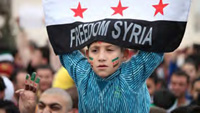Since the 2011 unrest in Syria the counting number of refugees has exceeded 2 million people and more than half of those refugees are children.
By Erica White
 A little over two and a half years ago, in March 2011, pro-democracy protests began in Damascus and the southern city of Deraa, Syria. These peaceful demonstrations were started as a salute of solidarity for Syria’s Arab neighbors who had brought about political change through the so-called “Arab Spring.” The protesters then demanded the release of political prisoners, and violence immediately ensued in Deraa, where security forces shot a number of protesters. The ensuing violent unrest has spiraled into a full-scale civil war spanning the entire country, with an estimated two million refugees displaced from the fighting, and a death toll well over 100,000.
A little over two and a half years ago, in March 2011, pro-democracy protests began in Damascus and the southern city of Deraa, Syria. These peaceful demonstrations were started as a salute of solidarity for Syria’s Arab neighbors who had brought about political change through the so-called “Arab Spring.” The protesters then demanded the release of political prisoners, and violence immediately ensued in Deraa, where security forces shot a number of protesters. The ensuing violent unrest has spiraled into a full-scale civil war spanning the entire country, with an estimated two million refugees displaced from the fighting, and a death toll well over 100,000.
Syria’s history, like many of its Middle Eastern neighbors, has been fraught with corruption, imperialism, war, and civil unrest. After World War I and the fall of the Otto-man Empire, Syria was placed under French mandate, during which time Syria was divided into three autonomous regions – with separate regions for the Alawites and the Druze. After World War II, the French were replaced by the Baath Party, and Syria briefly joined in a union with Egypt to become the United Arab Republic under Gamal Abdel Nasser.
After a series of wars with Israel and a military coup against the Baath party, the Assad family seized power, and Bashar al-Assad, the second son of former President Hafez al-Assad, holds office to this day. Although originally he announced some conciliatory measures, like releasing dozens of political prisoners and lifting the 48-year-old state of emergency, Assad’s reaction to the protests has been violent and iron-fisted.
Army tanks were called into numerous cities around Syria to squash anti-regime protests, and the military has been constantly used to dissemble any form of protest. Last month, the government and possibly rebel forces used rockets that released sarin gas, a biological weapon, in the Ghouta area of Damascus, which sparked international outcry. President Obama, at a press conference in Stockholm, said, “We have been very clear to the Assad regime, but also to other players on the ground, that a red line for us is we start seeing a whole bunch of chemical weapons moving around or being utilized.”
The international community, while gravely aware of the situation in Syria, has been wary to intervene because of the fragile situation on the ground, and the chaotic power vacuum that might erupt if the Assad regime is taken out. Syria is a very diverse country, with Sunni and Shia, Christian, Druze, Alawite, Kurdish, and Turkish communities that are all looking to have a say in whatever government comes after the Assad regime.
Focus on Refugees
As of September 26, 2013, 2,114,446 people were either registered as refugees or awaiting registration because of the unrest in Syria. According to United Nations High Commissioner for Refugees (UNHCR), “The exodus of Syrian refugees accelerated dramatically in recent months, with over 1 million refugees arriving in the first five months of 2013 alone. More than half of registered refugees are children and three quarters of registered refugees are living with local host families and communities in both urban and rural areas. If current trends persist, it can be expected that over 3 million Syrians would have left their country by the end of 2013.”
For further information, please contact:
Todd Wilson
Strategic Communications Director
p – 516.237.8634
e – twilson@adelphi.edu